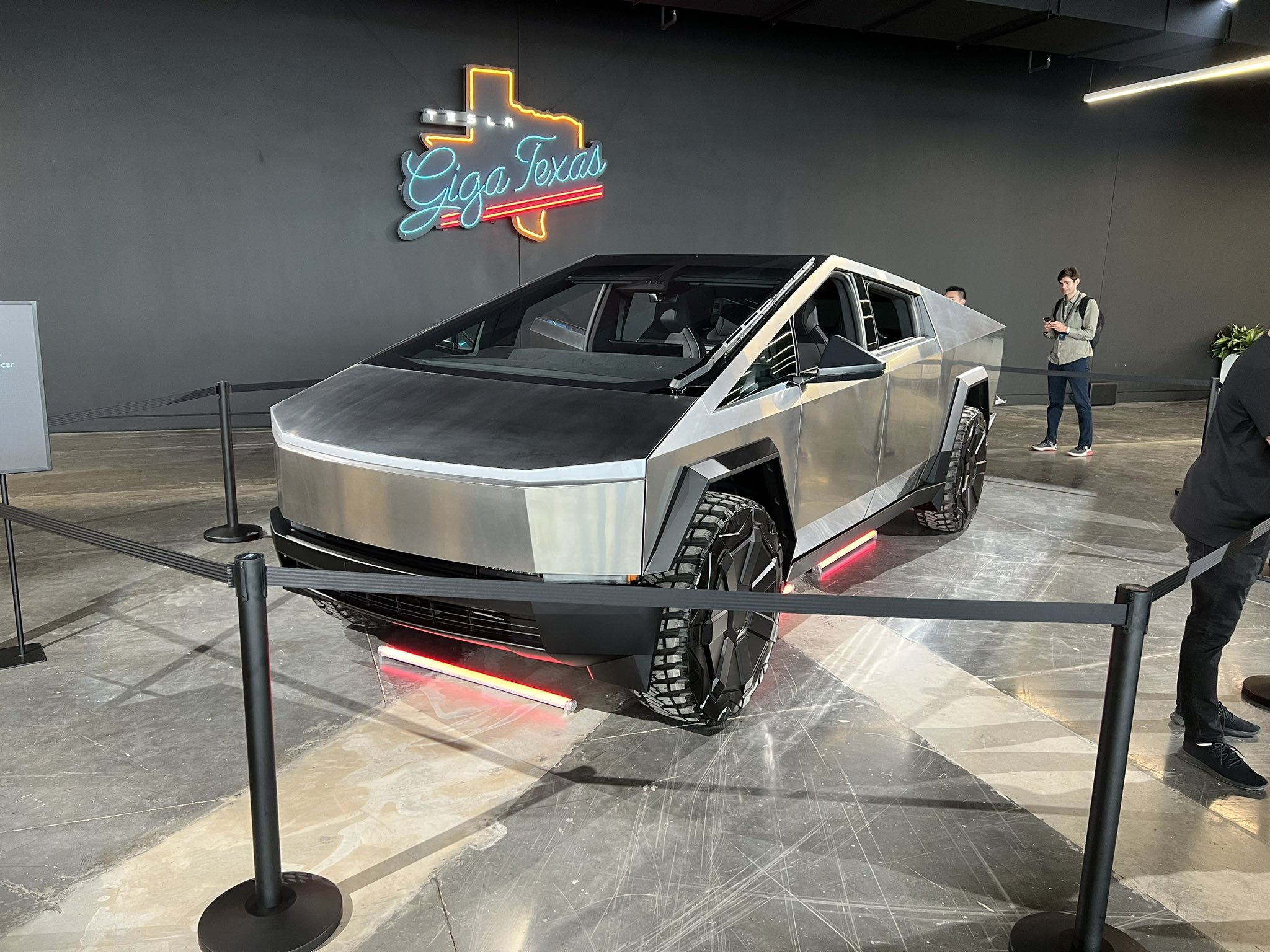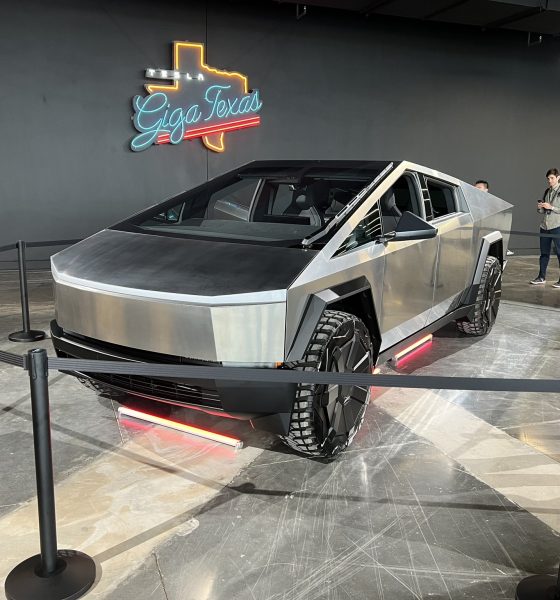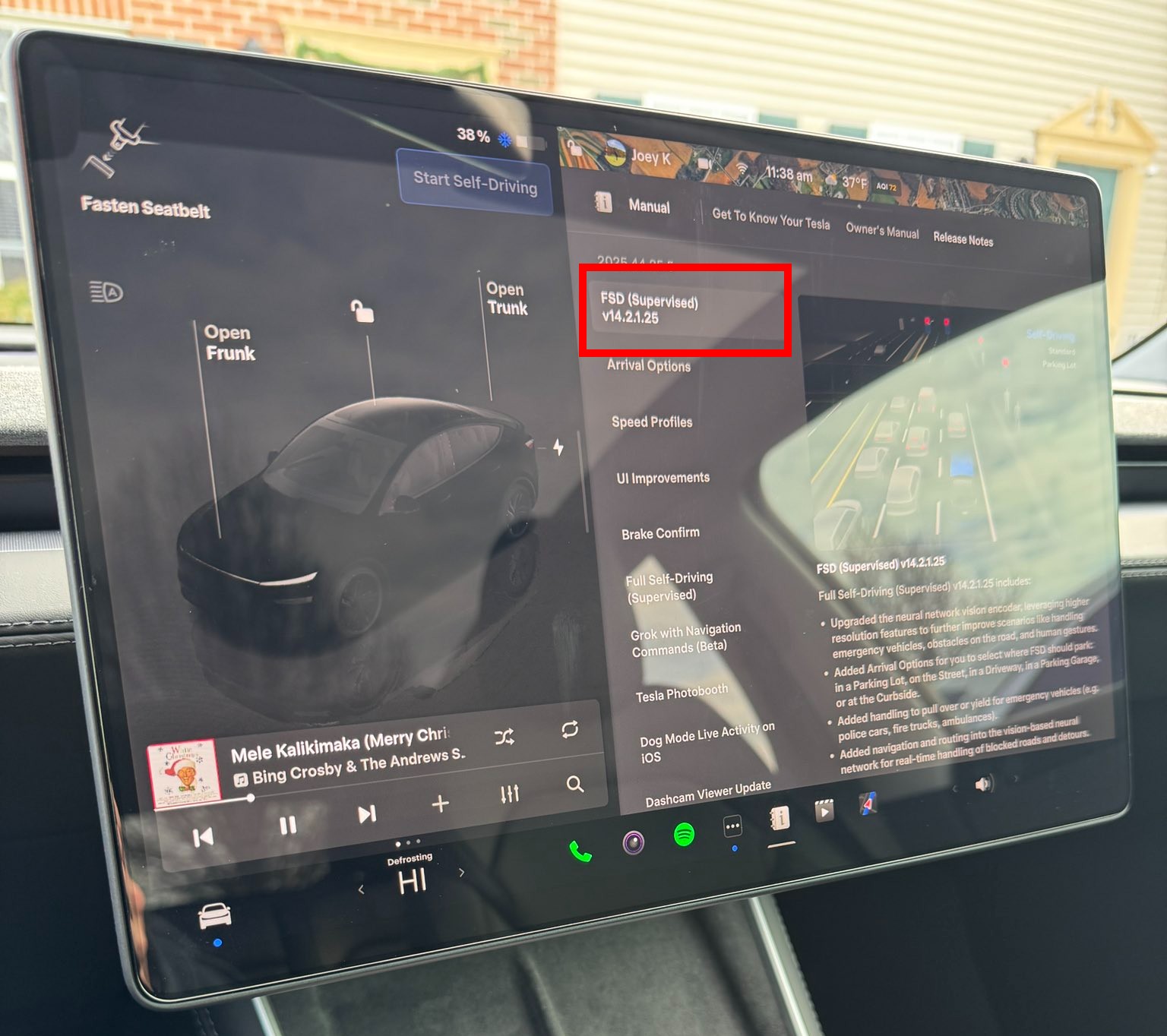

Video
Tesla Cybertruck details are coming to light months before scheduled production
Tesla Cybertruck details are coming to light months before the all-electric truck is scheduled to begin production. Executives and those close to the development of the Cybertruck reportedly gave more details about the vehicle ahead of its Summer production dates to various people at last week’s Investor Day.
Cybertruck enthusiast Matthew Donegan-Ryan attended the Investor Day event and spoke to several people involved with the Cybertruck program at Tesla. Among the details that were talked about at the event were the dimensions of the Cybertruck, its planned configurations, standard features, and even an in-house team responsible for developing accessories for the truck.
Dimensions
The dimensions of the Pre-Production Beta that was on display at the Investor Day were obtained by Donegan-Ryan by using the measure app on his iPhone, and he believes he’s within between .5″ and 2″ from what will be released by Tesla in the Summer. The Cybertruck at the event was comparable to Ford Super Crew Raptors, a vehicle that Donegan-Ryan said he has owned three of. “The Cybertruck is just a little more compact,” he told us.
EXCLUSIVE: CyberTruck Dimensions: it’s just a little smaller than a Ford F-150 Raptor; about 1.5” shorter and 2.5” narrower, but has a ~6” longer bed thanks to the shorter hood. pic.twitter.com/QQkAky3gsh
— Matthew Donegan-Ryan (@MatthewDR) March 10, 2023
The Staff that gave details on the Cybertruck dimensions couldn’t be named, but we were told that they will likely be seen front-and-center when initial deliveries begin, which will likely be marked by a dedicated event like past vehicles.
They said the dimensions were “about 5% smaller than the prototype unveiled in 2019″ and has more usable space despite its smaller size compared to the F-150 Raptor.
Tesla Cybertruck makes a tight squeeze through Boring Company tunnel
Elon Musk said on numerous occasions that the Cybertruck would be reduced in size for various reasons, including its need to fit in Boring Company tunnels.
However, this size reduction resulted in the loss of the front center seat. The Cybertruck will now seat five people.
Configurations
Tesla will develop two configurations, according to the information given to Donegan-Ryan: a Dual Motor and a “Performance,” which could potentially be a Tri-Motor build.
Discussions with the Tesla staff seemed to indicate Tesla would not go forward with the potential Quad-Motor powertrain and would instead develop a Tri-Motor powertrain for the Cybertruck, which is utilized in the Model S and Model X Plaid.
According to a reservation tracker, the Cybertruck’s Single Motor configuration, which was priced at $39,990 after the unveiling in 2019, will not be developed.
However, after discussions with staff, I believe Tesla is reverting back to the Tri-Motor powertrain for the CyberTruck like a Model S/X Plaid. There will be no single-motor. pic.twitter.com/czkyN6C5uJ
— Matthew Donegan-Ryan (@MatthewDR) March 10, 2023
Standard Features
All Cybertruck configurations will have rear-wheel steering, which has been seen among various prototypes over the past few years.
The Steering Wheel will be a combination of both the Yoke and traditional round option Tesla offered previously. This was detailed in several photographs from the event.
Tesla cybertruck with more “round” steering yolk. pic.twitter.com/wspu40VpO3
— Sofiaan Fraval (@Sofiaan) March 1, 2023
The Cybertruck will also feature standard air suspension, which was shown in more recent sightings of the vehicle prior to the Investor Day event. Air suspension has always been in the plans, as Musk has stated that the Cybertruck will need to be able to handle excessive payloads for construction applications, and it could also be utilized for Baja racing.
18″ wheels will come standard, and rim and tire packages will be available in a few different options. All-Terrain and All-Season tires will be suitable for the Cybertruck and it appears Goodyear will be the manufacturer responsible for the
Goodyear is the CyberTruck tire manufacture of the pictured All-Terrain tire. Going by the cost of Goodyear’s other A/T tires, we can budget for a $385/ea tire price. pic.twitter.com/QvwqQRiJjL
— Matthew Donegan-Ryan (@MatthewDR) March 10, 2023
Cybertruck Accessories Team
Tesla has established a Cybertruck Accessories Team for the vehicle, and instead of working with aftermarket companies to build add-ons, Tesla will do it themselves.
The Accessories team is being broken down into three categories: off-roading, camping, and racing, which will undoubtedly help drivers with various plans for the Cybertruck find a specific lineup of accessories that will fit their needs.
EXCLUSIVE: There is a secret CyberTruck Accessories team! I asked if @Tesla is working with aftermarket companies to build compatible 48v accessories like winches, offroad lights, etc. I was told Tesla have an in house team creating accessories! pic.twitter.com/cpFAkFpMGm
— Matthew Donegan-Ryan (@MatthewDR) March 10, 2023
The Cybertruck is still set for initial production in the Summer, as of now. Volume production is expected to begin in 2024, Musk said earlier this year.
You can check out Matthre Donegan-Ryan’s full video on the Cybertruck below.
I’d love to hear from you! If you have any comments, concerns, or questions, please email me at joey@teslarati.com. You can also reach me on Twitter @KlenderJoey, or if you have news tips, you can email us at tips@teslarati.com.

News
Tesla Robotaxi goes driverless as Musk confirms Safety Monitor removal testing
This development, in terms of the Robotaxi program, is massive. Tesla has been working incredibly hard to expand its fleet of Robotaxi vehicles to accommodate the considerable demand it has experienced for the platform.

Tesla has started Robotaxi testing in Austin, Texas, without any vehicle occupants, the company’s CEO Elon Musk confirmed on Sunday. Two Tesla Model Y Robotaxi units were spotted in Austin traveling on public roads with nobody in the car.
The testing phase begins just a week after Musk confirmed that Tesla would be removing Safety Monitors from its vehicles “within the next three weeks.” Tesla has been working to initiate driverless rides by the end of the year since the Robotaxi fleet was launched back in June.
Two units were spotted, with the first being seen from the side and clearly showing no human beings inside the cabin of the Model Y Robotaxi:
A Tesla without a driver was spotted traveling on public roads! pic.twitter.com/ZLbduf4cKa
— TESLARATI (@Teslarati) December 14, 2025
Another unit, which is the same color but was confirmed as a different vehicle, was spotted just a few moments later:
NEWS: A second Tesla Model Y Robotaxi running FSD Unsupervised has just been spotted driving itself on public roads in Austin, Texas, with no one in the front seats.
This is a different car from the one spotted earlier. They have different license plates.
h/t @Mandablorian https://t.co/5URYsUGyD0 pic.twitter.com/CIUi4mXi33
— Sawyer Merritt (@SawyerMerritt) December 14, 2025
The two units are traveling in the general vicinity of the South Congress and Dawson neighborhoods of downtown Austin. These are located on the southside of the city.
This development, in terms of the Robotaxi program, is massive. Tesla has been working incredibly hard to expand its fleet of Robotaxi vehicles to accommodate the considerable demand it has experienced for the platform.
However, the main focus of the Robotaxi program since its launch in the Summer was to remove Safety Monitors and initiate completely driverless rides. This effort is close to becoming a reality, and the efforts of the company are coming to fruition.
Testing is underway with no occupants in the car
— Elon Musk (@elonmusk) December 14, 2025
It is a drastic step in the company’s trek for self-driving technology, as it plans to expand it to passenger vehicles in the coming years. Tesla owners have plenty of experience with the Full Self-Driving suite, which is not fully autonomous, but is consistently ranked among the best-performing platforms in the world.
News
Tesla refines Full Self-Driving, latest update impresses where it last came up short
We were able to go out and test it pretty extensively on Saturday, and the changes Tesla made from the previous version were incredibly impressive, especially considering it seemed to excel where it last came up short.

Tesla released Full Self-Driving v14.2.1.25 on Friday night to Early Access Program (EAP) members. It came as a surprise, as it was paired with the release of the Holiday Update.
We were able to go out and test it pretty extensively on Saturday, and the changes Tesla made from the previous version were incredibly impressive, especially considering it seemed to excel where it last came up short.
Tesla supplements Holiday Update by sneaking in new Full Self-Driving version
With Tesla Full Self-Driving v14.2.1, there were some serious regressions. Speed Profiles were overtinkered with, causing some modes to behave in a strange manner. Hurry Mode was the most evident, as it refused to go more than 10 MPH over the speed limit on freeways.
It would routinely hold up traffic at this speed, and flipping it into Mad Max mode was sort of over the top. Hurry is what I use most frequently, and it had become somewhat unusable with v14.2.1.
It seemed as if Speed Profiles should be more associated with both passing and lane-changing frequency. Capping speeds does not help as it can impede the flow of traffic. When FSD travels at the speed of other traffic, it is much more effective and less disruptive.
With v14.2.1.25, there were three noticeable changes that improved its performance significantly: Speed Profile refinements, lane change confidence, and Speed Limit recognition.
🚨 Many of you asked us to test highway driving with Tesla Full Self-Driving v14.2.1.25. Here’s what we noticed:
✅ Speed Profiles are significantly improved. Hurry Mode is no longer capped at 10 MPH over the speed limit, and now travels with the flow of traffic. This is much… pic.twitter.com/48ZCGbW0JO
— TESLARATI (@Teslarati) December 13, 2025
Speed Profile Refinement
Speed Profiles have been significantly improved. Hurry Mode is no longer capped at 10 MPH over the speed limit and now travels with the flow of traffic. This is much more comfortable during highway operation, and I was not required to intervene at any point.
With v14.2.1, I was sometimes assisting it with lane changes, and felt it was in the wrong place at the wrong time more frequently than ever before.
However, this was one of the best-performing FSD versions in recent memory, and I really did not have any complaints on the highway. Speed, maneuvering, lane switching, routing, and aggressiveness were all perfect.
Lane Changes
v14.2.1 had a tendency to be a little more timid when changing lanes, which was sort of frustrating at times. When the car decides to change lanes and turn on its signal, it needs to pull the trigger and change lanes.
It also changed lanes at extremely unnecessary times, which was a real frustration.
There were no issues today on v14.2.1.25; lane changes were super confident, executed at the correct time, and in the correct fashion. It made good decisions on when to get into the right lane when proceeding toward its exit.
It was one of the first times in a while that I did not feel as if I needed to nudge it to change lanes. I was very impressed.
Speed Limit Recognition
So, this is a complex issue. With v14.2.1, there were many times when it would see a Speed Limit sign that was not meant for the car (one catered for tractor trailers, for example) or even a route sign, and it would incorrectly adjust the speed. It did this on the highway several times, mistaking a Route 30 sign for a 30 MPH sign, then beginning to decelerate from 55 MPH to 30 MPH on the highway.
This required an intervention. I also had an issue leaving a drive-thru Christmas lights display, where the owners of the private property had a 15 MPH sign posted nearly every 200 yards for about a mile and a half.
The car identified it as a 55 MPH sign and sped up significantly. This caused an intervention, and I had to drive manually.
It seems like FSD v14.2.1.25 is now less reliant on the signage (maybe because it was incorrectly labeling it) and more reliant on map data or the behavior of nearby traffic.
A good example was on the highway today: despite the car reading that Route 30 sign and the Speed Limit sign on the center screen reading 30 MPH, the car did not decelerate. It continued at the same speed, but I’m not sure if that’s because of traffic or map data:
🚨 We listened to and read a lot of you who had a complaint of Tesla Full Self-Driving v14.2.1 incorrectly reading Speed Limit signs
This appears to be resolved in v14.2.1.25.
Here’s a breakdown: pic.twitter.com/TEP03xrMbt
— TESLARATI (@Teslarati) December 13, 2025
A Lone Complaint
Tesla has said future updates will include parking improvements, and I’m really anxious for them, because parking is not great. I’ve had some real issues with it over the past couple of months.
Today was no different:
🚨 My lone complaint with my drive on Tesla FSD v14.2.1.25 was this strange parking instance.
FSD swung out wide to the left to pull into this spot and this is where it seemed to be stumped. I gave it about 10 seconds after the car just stopped moving for it to make some… https://t.co/ZEkhTHOihG pic.twitter.com/TRemXu5DLf
— TESLARATI (@Teslarati) December 13, 2025
Full Self-Driving v14.2.1.25 is really a massive improvement over past versions, and it seems apparent that Tesla took its time with fixing the bugs, especially with highway operation on v14.2.1.
News
Tesla Optimus dramatically collapses after teleoperator mishap
It seemed blatantly obvious that whoever was controlling the Optimus robot from behind the scenes did not disconnect their ability to manipulate its movements

Tesla Optimus dramatically collapsed after a teleoperator mishap at the company’s “Future of Autonomy Visualized” event in Miami this past weekend.
It seemed blatantly obvious that whoever was controlling the Optimus robot from behind the scenes did not disconnect their ability to manipulate its movements, then left the controls, causing Optimus to collapse.
A video captured at the event shows Optimus doing a movement similar to taking a headset off, likely what the teleoperator uses to hear guest requests and communicate with other staff:
🚨 Tesla Optimus mishap at the Miami event
To be fair, don’t we all want to do this around the Holidays? pic.twitter.com/EJ5QKenqQd
— TESLARATI (@Teslarati) December 8, 2025
After the headset removal motion was completed, Optimus simply collapsed backward, making for an interesting bit of conversation. While it was a mishap, it was actually pretty funny to watch because of the drama displayed by the robot in the situation.
This was obviously a mistake made by the teleoperator, and does not appear to be a spot where we can put any sort of blame on Optimus. It would have likely just stood there and waited for controls to resume if the teleoperator had disconnected from the robot correctly.
However, details are pretty slim, and Tesla has not announced anything explaining the situation, likely because it seems to be a pretty face-value event.
Tesla Optimus shows off its newest capability as progress accelerates
The Tesla Optimus program has been among the most hyped projects that the company has been working on, as CEO Elon Musk has extremely high hopes for what it could do for people on Earth. He has said on several occasions that Optimus should be the most popular product of all time, considering its capabilities.
Obviously, the project is still a work in progress, and growing pains are going to be part of the development of Optimus.
In its development of Optimus Gen 3, Tesla has been working on refining the forearm, hand, and fingers of Optimus, something that Musk said is extremely difficult. However, it’s a necessary step, especially if its capabilities will not be limited by hardware.
All in all, Optimus has still been a very successful project for Tesla, especially in the early stages. The company has done an excellent job of keeping Optimus busy, as it helps with serving customers at events and the Tesla Diner, and is also performing tasks across the company’s manufacturing plants.








